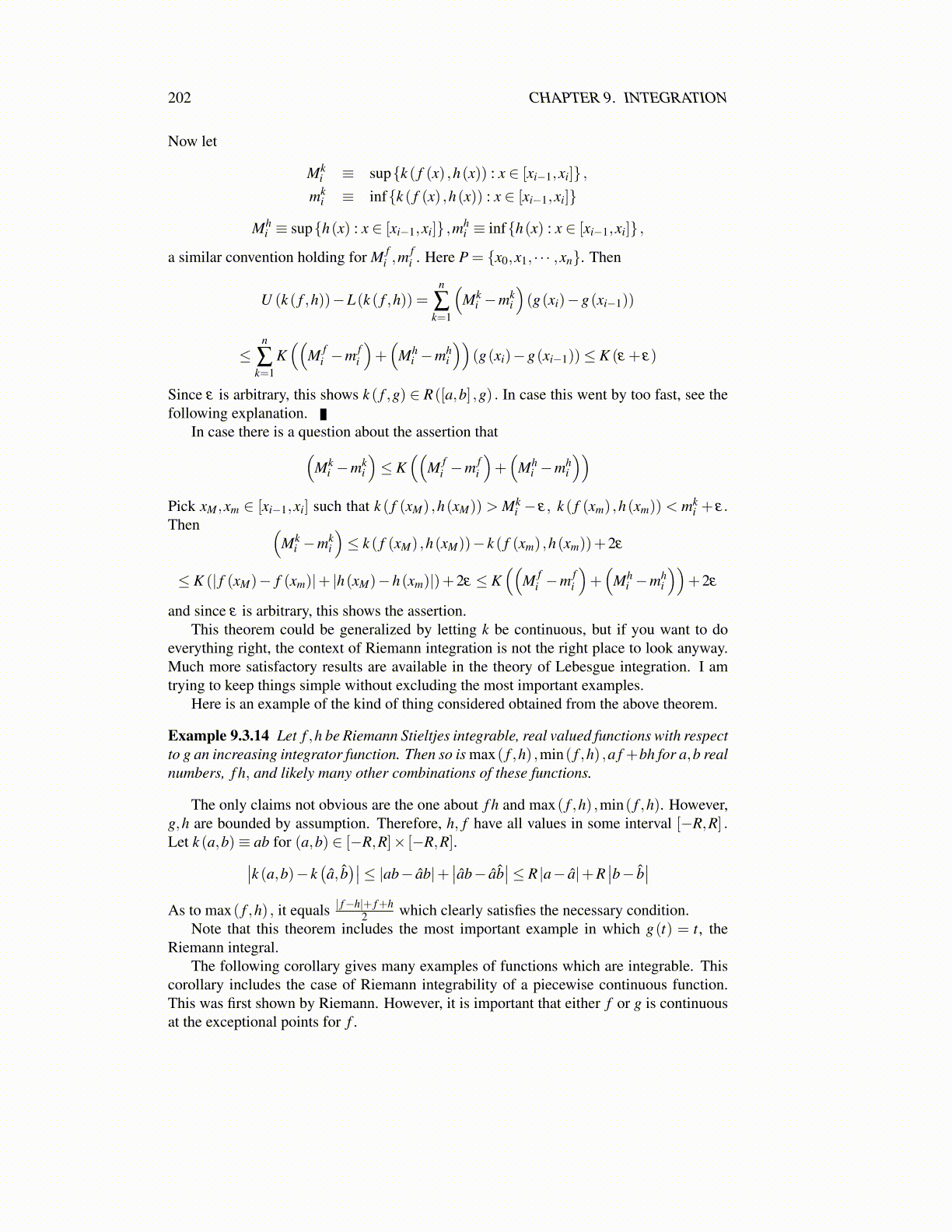
202 CHAPTER 9. INTEGRATION
The situation for piecewise continuous functions is stated as the following corollary. Iwill give a proof because this is, in my opinion, the most important case and it won’t hurtto have a new and maybe more elementary proof. In this corollary, the integrator functionis g(t) = t.
Corollary 9.3.18 Let f : [a,b]→ R be piecewise continuous. Then f is Riemann inte-grable. Also ∫ b
af dt =
n
∑i=1
∫ zi
zi−1
gidt (9.5)
Where gi = f on (zi−1,zi) with gi continuous on [zi−1,zi].
Proof: Let Pi be a partition for [zi−1,zi] . Since there are only finitely many of theseintervals, there exists δ > 0 such that if ∥Pi∥< δ , then for each i,∣∣∣∣∣∑Pi
gi−∫ zi
zi−1
gidt
∣∣∣∣∣< ε
Let M f be an upper bound for | f | on [a,b], Mg an upper bound for all |gi|. Now let ∥P∥<δ < ε where P is a partition of [a,b] , these points denoted as x j. Let P̂i be those points ofP which are in (zi−1,zi] and let Pi consist of P̂i along with zi−1 and zi. Thus ∥Pi∥< δ . Thenfor yi ∈ [xi−1,xi] ,∣∣∣∣∣ n
∑i=1
∫ zi
zi−1
gidt−∑P
f
∣∣∣∣∣≤ n
∑i=1
∣∣∣∣∣∣∫ zi
zi−1
gidt− ∑x j∈P̂i
f (y j)(x j− x j−1
)∣∣∣∣∣∣Now for x j ∈ P̂i, f (y j) = gi (y j) except maybe at end points where these differ by no morethan 2
(M f +Mg
)≡ 2M. Thus the above is no more than
≤n
∑i=1
∣∣∣∣∣∫ zi
zi−1
gidt− ∑x j∈Pi
gi (y j)(x j− x j−1
)∣∣∣∣∣+ n
∑i=1
4(M f +Mg
)δ
< nε +4Mnδ < ε (n+4Mn)
Since ε is arbitrary, this shows that f is indeed Riemann integrable and equals 9.5.Recall that every bounded variation real function is the difference of two increasing
functions. This is Proposition 9.3.2. Then one can easily generalize the above Corollary9.3.15 to the case where g is only real and of bounded variation.
Corollary 9.3.19 Let g be the difference of two increasing functions g= g1−g2 definedon [a,b] and let f be bounded by M and is continuous on [a,b] except at finitely many points{c1, · · · ,cr}. At these points either f or both g1,g2 are continuous. Then
∫ ba f dg exists.
Proof: The details are left to the reader. However, you simply apply the above Corollary9.3.15 to
∫ ba f dg1 and
∫ ba f dg2 and then note that from the definition,
∫ ba f dg =
∫ ba f dg1−∫ b
a f dg2The above has given many examples of functions which are integrable. Now here is
one which is not integrable with respect to any continuous bounded variation function.